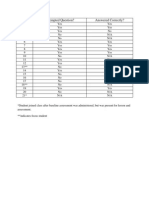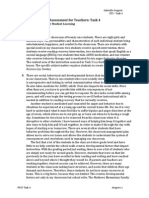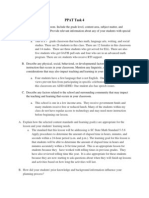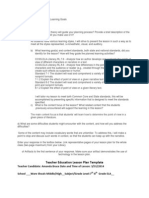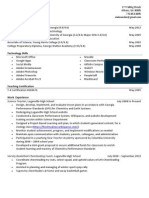Task 3 Final
Task 3 Final
Uploaded by
api-122378129Copyright:
Available Formats
Task 3 Final
Task 3 Final
Uploaded by
api-122378129Original Title
Copyright
Available Formats
Share this document
Did you find this document useful?
Is this content inappropriate?
Copyright:
Available Formats
Task 3 Final
Task 3 Final
Uploaded by
api-122378129Copyright:
Available Formats
Mary Margaret ONeal PPAT Task 3 Textbox 3.
0: Contextual Factors In my 2nd grade classroom, there are twenty-three students. I teach every subject area: Reading, Math, Science, Social Studies, and Writing. I have three students who need to wear glasses to see the board. I also have four students who are English Second Language students and two of those students receive speech assistance twice a week. I have a student who is in the special education class but is in our class for socialization. Another student attends the special education class for reading help. In addition, another student attends extended resource three times a week. The students who need assistance create challenges during instructional time. Instructions have to be repeated multiple times for each group and four students have to have their test read to them to meet their IEP needs. To meet these needs, I have the students repeat the information back to me so that I know they understand the information. After whole group teaching or instruction, I make my way around the room giving assistance to each group. This allows for one on one attention that many students need to get the most of their learning experience. Two of my students that attend the special education class both have problem socializing with other around them. This affects the classroom because their behavior is handled separately. A handful of my students come from homes where their parents have to work late so the students are staying with relatives most of the time. This affects the students behavior in the classroom. This causes disruptions for the other students in the classroom. After school activities are in full swing this time of the year so that has an effect on many of my students. Many days, students come in worn out and tired because of the activities they had the day before that wore them out. This creates a potential problem if I do not get the students up and moving to help keep them away. Allowing my students to change positions, from the carpet to their seats, helps keep them going and awake. I also try to incorporate many hands-on activities for the students to interact with so that they are up and moving and interacting with one another. Textbox 3.1.1 My learning theory is that all students need individualized help for them to succeed. In my class, I try to work with students in small groups so that they will receive the attention that they deserve. I give directions to my students and then tend to the students who need a little more help. Being able to work with the students on a small group level has helped the students. The students who need smaller groups seem to better understand the assignment after it is repeated in a small group. They also feel more comfortable with asking questions rather than asking questions whole group.
The standard I used for this lesson was: Math 2.7MD: Tell and write time from analog and digital clocks to the nearest five minutes, using a.m. and p.m. After picking this standard, I could better chose my activities to fit the needs of my students as well as following the standard. The planned learning activities will include hands on activities as well as real life situations. Providing the students will real life situations to relate with the subject of time will allow them to better understand how to use it in the real world. The content focus of this lesson is using math in real world situations; better known as telling time from an actual clock. This information will feed off of already knowing simple math. Students have already learned addition and subtraction. They already know that time is related to the day and that minutes are related to time, also. The students will use this in everyday life. Telling time can be a difficult skill for students to understand. Sometimes, students can confuse the hands on a clock or the amount of minutes in an hour and the hours in a day. To help students with remembering the difference between the two hands, I would use a song to remind the students which hade is which. Songs or poems have always helped in my classroom to grab the students attention and allow them to remember information in a catchy way. Textbox 3.1.2 One instructional strategy I use in my classroom is a whole group instruction. I allow the students to come to the floor to work together to gain information. For this strategy, I use technology to engage the students. The students interact with the strategy and can answer questions together. This strategy helps the students pay attention and possibly learn from their friends. A second strategy I would use would be small group instructions. I believe that this strategy is most effective for my students because it allows the students to feel that they are getting one on one attention while you are working with more than one student. Students also feel more comfortable about asking questions when they are in small groups. A third strategy I would use is to have the students work in groups with mixed learning levels. This helps some students learn from their peers and other students help their peers with issues they may have. For this strategy to be effective, the groups have to planned so that they equal out to everyone having a positive outcome. The teacher would guide the groups by asking different questions and pulling different ideas for the teams to work on. These instructional strategies connect to the learning goal because all of the learning styles have a positive effect on the students. In one way or another, the students are working hard to understand the information. Each strategy also gives the students different ways to view the material. My decision to use all three instructional styles was based on the fact that every student learns differently. In my classroom, I have students who have a positive result because of different
styles of teaching. I want what is best for my students so to facilitate different ways to learn will help each student in their own way. Textbox 3.1.3 Incorporating technology into my lessons will show the students a different way to view time and how they can use it in the real world. There are many applications that can use in the classroom to help my students learn to tell time. Students will be able to play these games when we have the iPad Mini cart to use in the classroom. Another activity that I will do will be an ongoing activity. The students will have their own clocks on their desk. I will randomly ask the students to set their clock throughout the day. I will take anecdotal notes on who is having trouble with setting an analog clock. A whole group activity that I will complete with the class is creating a flower clock. The flower clock consist of creating a flower head that has numbered petals to match the numbers on a clock. This is taped to a white board so that students can be given a time, and they can create it on the clock. The flower clock is analog and you write the digital time on leaves under the flower head. These activities address the student needs because there are independent activities, whole group activities, and activities that are self correcting so the students need little assistance while completing the games on the iPads. The activities also work well with the class demographics because it allows the students to work with materials they may not have at home, as well as activities that they can complete with others if needed. Textbox 3.1.4 There are many materials that can be used to assist with teaching telling time. Different materials include iPads, SMARTboard, individual clocks, and craft ideas such as a clock plate. These materials will allow the students to work individually, small group, and whole group. Including these different learning strategies will help the students succeed. This chosen technology will enhance instruction because it allows the students to interactive with the subject. It allows the students to compelte activities on their own that will correct then when they are wrong so that they will learn from their mistakes. The use of technology will enhance each students learning because technology can open many doors for the students to explore. Textbox 3.2.1 Focus Student 1 Focus Student 1 is a very strong student who completes their work quickly and efficiently. This student came into the lesson already knowing the basics of telling time. This unit cleared up any loose ends that they may have had about telling time. Focus Student 1 helps the other in their group understand the material. They are patient with the others while they figure out the information. This can create a challenge for Focus Student 1 because they complete their work quickly but can make mistakes by not taking their time to read the information fully. This creates careless mistakes that shouldnt happen.
One way that Focus Student 1 learns is by teaching others the information. This helps the student understand the information while they are helping others understand the information too. Teaching the information is a learning style of this student that will help them meet the learning goal of this unit. Other than anecdotal notes and the final assessment, I will use the work that is completed in between along with the results of their iPad activities to see how they are progressing through the information. Focus Student 2 Focus Student 2 is a student who works well in small groups. They like to learn from their peers and listen closely to do so. This is an English Second Language student who has a hard time understanding simple activities. They work very hard to do their best and understand what is going on in the lesson. This creates challenges when the students is working toward learning goals. This student works well on the iPad applications and likes to work hard to get the correct answer. Focus Student 2 also answers many questions during whole group instruction but would rather wait for small group time to ask questions. To help this student, I place them in group with a leader who will take time to help Focus Student 2 understand the information and get the correct answer. Pairing Focus Student 1 and Focus Student 2 together works very well because they help each other in different ways. To see how Focus Student 2 is progressing, I will have them complete activities along the way that shows how they are progressing. This information will help see how much they have learned by the end of the unit. Anecdotal notes, the final assessment, and iPad results will also provide information on how this student is progressing towards the learning goal and what they will need to work on. Textbox 3.3.1 This lesson facilitated student learning throughout the entire lesson. Students were working hands on with technology, working in groups to help each other with information, and independently to see what they student knows. To support this, notes were taken throughout the lesson about students who seemed to have trouble with the information. Also, students who were having trouble were given time to work in small groups with other students so that they could gain information from the other students. While the students were working together to create the flower clock, students were help and supportive of one another. For example, one student was having trouble remembering which hand was the hour hand and which hand was the minute hand. The class came together to help the student out by giving them helpful ways to remember the difference. This helped the student sharing the information because they were teaching their fellow students. The students who were listening also learned a new way to remember which hand was which. This helps the students grow in their knowledge as well as helping their classmates. This was also a way that the lesson was adapted to help engage the students during whole group instruction. Allowing
the students to work together to remember information is more meaningful to them because they are coming up with the solutions. I allowed the students to work together because this allowed them to feel like they were the teachers. The students were allowed to engage with one another and help others who were in need. I also fostered student-teacher interactions by working my way through the groups and guiding the students on how to add to their understanding. I provided the students with different questions and scenarios that they could work through together. During the lesson, I made sure to correct students in a positive way. I made sure the student knew that how they were answering the questions was not the best possible answer and then I provided them with information that could help them fix their problems. This allows the students to have a positive reaction even if they didnt chose the best answer. Textbox 3.3.2 Focus Student 1 and Focus Student 2 both completed their assessment successfully. Focus Student 1 completed their assessment with only one mistake. This shows that the student has an understanding of the information. Overall, Focus Student 1 made a satisfactory grade for the unit of telling time. Focus Student 2 had a few more mistakes on the final assessment. The mistakes that were made stemmed from a language barrier for this student. To better assist this student, I would provide a word back for the vocabulary section. Many times a language barrier can cause a misunderstanding of the questions. Allowing the students to work together would allow the students to succeed at meeting the learning goal. Even with the assessment being read to Focus Student 2, the outcome still did not come out to be perfect. After reviewing the work that the student competed throughout the lesson and the final assessment, the student seems to understand the information of telling time but not in the form of a formal test like the final assessment. Having a more hands on final assessment would have better suit Focus Student 2. Textbox 3.4.1 Specifically, the students who do not achieve the learning goal will complete interactive activities one on one with the teacher. These activities will include work with the iPad as well as activities that are hands on. The students who did not meet the learning goal were students who tend to stray off of subject and need that one on one attention to succeed at their work. These students work well in small groups and thrive off of having other students to work with but still do not grasp the information until they have one on one time with the teacher reviewing the steps that they need. In my future lessons, I will make sure to plan more activities for the students to complete independently or in small groups so that there will be more time for me to work with the students who need more small group or one on one attention. My lessons will definitely include interactive and hands on activities for the students to complete. The students also enjoy
different iPad applications that go along with what we are working on because it is familiar to them and makes them excited about learning. Incorporating technology into a lesson will allow the students to use it to their advantage of learning while having fun and playing games. Textbox 3.4.2 I will base my plans off of the information that I have gained from this analysis. The students will flourish off of working with one another and teaching each other the information they know. For Focus Student 1, I will continue to put them into groups that need a leader. A leader that will help them understand the information while working on group projects. To benefit Focus Student 2, I will incorporate small group activities and independent work that will allow more time to work with him one on one.
You might also like
- Instructional and Support Resources ChartDocument2 pagesInstructional and Support Resources Chartapi-176741846100% (8)
- Ppat-Task 2 FinalDocument7 pagesPpat-Task 2 Finalapi-200821541100% (2)
- Ppat Task 2Document11 pagesPpat Task 2api-254265847100% (4)
- Support Resources ChartDocument2 pagesSupport Resources Chartapi-2008107240% (1)
- Task 1Document12 pagesTask 1api-200821541100% (8)
- Ppat Task 1 Re-SubmitDocument7 pagesPpat Task 1 Re-Submitapi-21355372967% (3)
- PPAT Task 1 Full InternshipDocument13 pagesPPAT Task 1 Full Internshipshynquiet98100% (3)
- Tws Contextual Factors ChartDocument3 pagesTws Contextual Factors Chartapi-1767418460% (1)
- Task 1 PpatDocument4 pagesTask 1 Ppatapi-176688637100% (7)
- Contextual Factors Chart Task 1 - PpatDocument3 pagesContextual Factors Chart Task 1 - Ppatapi-176688637100% (4)
- Ppat Task 2 Baseline DataDocument1 pagePpat Task 2 Baseline Dataapi-254265847No ratings yet
- Task 3 PpatDocument6 pagesTask 3 Ppatapi-176688637100% (2)
- Ppat Task 3 Submission 1Document13 pagesPpat Task 3 Submission 1api-213553729100% (3)
- Instrucational Resources Chart Artifact 2Document2 pagesInstrucational Resources Chart Artifact 2api-122547405100% (2)
- Final-Ppat-Task 4Document14 pagesFinal-Ppat-Task 4api-200821541100% (3)
- Ppat Task 1 Contextual Factors Chart BURTDocument2 pagesPpat Task 1 Contextual Factors Chart BURTrburtNo ratings yet
- Ppat Task 1Document7 pagesPpat Task 1api-242803577100% (1)
- Differentiated Lesson Plan fs2 - Task 3 - PpatDocument1 pageDifferentiated Lesson Plan fs2 - Task 3 - Ppatapi-176688637No ratings yet
- Ppat Task 2Document16 pagesPpat Task 2api-213553729100% (5)
- Contextual Factors CompletedDocument3 pagesContextual Factors CompletedHeather ForrestNo ratings yet
- 2020 Lesson Plan Template With PpatDocument3 pages2020 Lesson Plan Template With Ppatapi-359339664No ratings yet
- Contextual Factors ChartDocument2 pagesContextual Factors Chartapi-212499894No ratings yet
- Task 4 SubmissionDocument11 pagesTask 4 Submissionapi-213553729100% (1)
- CorpuzDocument2 pagesCorpuzapi-442046733100% (2)
- Instructional and Support Resources ChartDocument2 pagesInstructional and Support Resources Chartapi-242803577No ratings yet
- Ppat Section 2Document25 pagesPpat Section 2api-237235020100% (1)
- Task 2 PpatDocument5 pagesTask 2 Ppatapi-176688637100% (1)
- Task 2 and 3 PpatDocument8 pagesTask 2 and 3 Ppatapi-242292349100% (2)
- Ppat Task ThreeDocument7 pagesPpat Task Threeapi-122157048100% (1)
- Task 2 1 1 PpatDocument2 pagesTask 2 1 1 Ppatapi-176688637No ratings yet
- Ppat Task 4Document7 pagesPpat Task 4api-122157048100% (1)
- Task 4 PpatDocument4 pagesTask 4 Ppatapi-176688637100% (1)
- Ppat-Task 3 FinalDocument8 pagesPpat-Task 3 Finalapi-200821541100% (1)
- CorpuzDocument3 pagesCorpuzapi-442046733No ratings yet
- Contextual Factors Chart1Document4 pagesContextual Factors Chart1api-213553729No ratings yet
- Stacie Halas DecisionDocument48 pagesStacie Halas DecisiondennisjromeroNo ratings yet
- Beanbags LessonDocument3 pagesBeanbags Lessonapi-265562070No ratings yet
- Task 2 FinalDocument5 pagesTask 2 Finalapi-122378129100% (1)
- Ppat Task 2 Whole Class Assessment DataDocument1 pagePpat Task 2 Whole Class Assessment Dataapi-254265847100% (2)
- Task 4 AmberjordanDocument15 pagesTask 4 Amberjordanapi-200086677100% (2)
- T3-Artifact 1Document2 pagesT3-Artifact 1api-200821541No ratings yet
- T3-Artifact 2Document1 pageT3-Artifact 2api-200821541No ratings yet
- Task 2Document10 pagesTask 2api-242257516No ratings yet
- Task 3 AmberjordanDocument17 pagesTask 3 Amberjordanapi-200086677100% (4)
- Task 2 AmberjordanDocument15 pagesTask 2 Amberjordanapi-200086677100% (2)
- PPAT Task 1Document3 pagesPPAT Task 1Kaitlyn SorensenNo ratings yet
- Ppat Task Two 1Document7 pagesPpat Task Two 1api-122157048No ratings yet
- Textbox 1 2 1Document2 pagesTextbox 1 2 1api-200842148No ratings yet
- Textbox 1 2 3Document1 pageTextbox 1 2 3api-200842148No ratings yet
- PPAT Task 1 TemplateDocument6 pagesPPAT Task 1 TemplateLeslie RoudybushNo ratings yet
- Scoring Rubric Task 2 - PpatDocument1 pageScoring Rubric Task 2 - Ppatapi-176688637No ratings yet
- Textbox 1 1 1Document3 pagesTextbox 1 1 1api-200842148No ratings yet
- Contextual Factors ChartDocument2 pagesContextual Factors Chartapi-242803577No ratings yet
- T3-Artifact 3Document1 pageT3-Artifact 3api-200821541No ratings yet
- JasmineayeDocument2 pagesJasmineayeapi-213776717No ratings yet
- Textbox 1 2 4Document2 pagesTextbox 1 2 4api-200842148No ratings yet
- Lesson 3Document3 pagesLesson 3api-437998606No ratings yet
- Instructional and Support ResourcesDocument2 pagesInstructional and Support Resourcesapi-176200074No ratings yet
- Ppat Section 3Document8 pagesPpat Section 3api-237235020No ratings yet
- Language Arts (Eled 3226) Imb Teaching Clinical Experience Portfolio Meredith Mcdaniel Unc Charlotte-Elementary Education 3 GradeDocument11 pagesLanguage Arts (Eled 3226) Imb Teaching Clinical Experience Portfolio Meredith Mcdaniel Unc Charlotte-Elementary Education 3 Gradeapi-297926408No ratings yet
- Lbs 302 Managment Plan FinalDocument9 pagesLbs 302 Managment Plan Finalapi-452832924No ratings yet
- Blenderized Learning EnvironmentDocument12 pagesBlenderized Learning EnvironmentStefanieNo ratings yet
- Lesson 4 Adjectives - OnealDocument2 pagesLesson 4 Adjectives - Onealapi-122378129No ratings yet
- Lesson 2 Assessment DataDocument1 pageLesson 2 Assessment Dataapi-122378129No ratings yet
- Contextual Factors OnealDocument4 pagesContextual Factors Onealapi-122378129No ratings yet
- Lesson 4 ReflectionDocument2 pagesLesson 4 Reflectionapi-122378129No ratings yet
- Lesson Plan 2 OnealDocument3 pagesLesson Plan 2 Onealapi-122378129No ratings yet
- Lesson 1 Earth Materials Lesson PlanDocument4 pagesLesson 1 Earth Materials Lesson Planapi-122378129No ratings yet
- Lesson Plan3Document2 pagesLesson Plan3api-122378129No ratings yet
- Lesson Plan5Document2 pagesLesson Plan5api-122378129No ratings yet
- Lesson PlansDocument2 pagesLesson Plansapi-122378129100% (1)
- December Newsletter 1Document3 pagesDecember Newsletter 1api-122378129No ratings yet
- Misty Patureau Resume 2017 FinalDocument3 pagesMisty Patureau Resume 2017 Finalapi-374822493No ratings yet
- Strategies and For Effective Oral Reading of Grade 7 in Labrador National High SchoolDocument29 pagesStrategies and For Effective Oral Reading of Grade 7 in Labrador National High SchoolReno ReyesNo ratings yet
- Legal Bases (Hard Copy)Document5 pagesLegal Bases (Hard Copy)Renalyn Lumpay AñanoNo ratings yet
- Academic Transcript: End of Twbkwbis.P - OpendocDocument8 pagesAcademic Transcript: End of Twbkwbis.P - Opendocapi-331487809No ratings yet
- Courtney Lowe ResumeDocument2 pagesCourtney Lowe Resumeapi-127200231No ratings yet
- Lesson Plan 2 5e-Lesson-Plan-Template Final-M5a1Document3 pagesLesson Plan 2 5e-Lesson-Plan-Template Final-M5a1api-317794487No ratings yet
- Lecture MethodDocument16 pagesLecture MethodVaishali Gothwal100% (2)
- Guidelines For Private Schools in BhutanDocument15 pagesGuidelines For Private Schools in BhutanSonam Dorji0% (2)
- Education From The Bottom Up: UNICEF's Education Programme in SomaliaDocument16 pagesEducation From The Bottom Up: UNICEF's Education Programme in SomaliaLeo AlvarezNo ratings yet
- JKSC Franchisees Classes - MUSTDocument11 pagesJKSC Franchisees Classes - MUSThirannikNo ratings yet
- Love Is A FallacyDocument8 pagesLove Is A FallacyChrislyn AberinNo ratings yet
- Sample of Contextualized Lesson Plan in MathDocument41 pagesSample of Contextualized Lesson Plan in MathBeng FranciscoNo ratings yet
- Technology Enhanced Blended Learning Lesson PlanDocument3 pagesTechnology Enhanced Blended Learning Lesson Planapi-334622058No ratings yet
- Action Research - Integrating Technology Into ClassroomDocument19 pagesAction Research - Integrating Technology Into ClassroomHoang Duyen AnhNo ratings yet
- Definitions For Annual School Census Data - Primary and Secondary SchoolsDocument7 pagesDefinitions For Annual School Census Data - Primary and Secondary SchoolsMuhammad Zaheer AnwarNo ratings yet
- The Elements of Teaching and LearningDocument11 pagesThe Elements of Teaching and LearningEllaine Grace Delima GurroNo ratings yet
- Math Sheets For Grade 1Document3 pagesMath Sheets For Grade 1Gary0% (3)
- Philosophy of EducationDocument1 pagePhilosophy of Educationapi-273441949No ratings yet
- School Grade Teacher Jevy Rose D. Paz Subject Date Grading Time Instructor Teodora Mangilaya I. ObjectivesDocument7 pagesSchool Grade Teacher Jevy Rose D. Paz Subject Date Grading Time Instructor Teodora Mangilaya I. ObjectivesJevy Rose Dimalaluan PazNo ratings yet
- Sight Vocab Jun in FDocument8 pagesSight Vocab Jun in FPoppi HSNo ratings yet
- Lobal Leaders, Elite Education (GLEE) Is A: General Services IncludeDocument3 pagesLobal Leaders, Elite Education (GLEE) Is A: General Services Includehherizo1187No ratings yet
- LDM1 Module 4 Implementation Plan TemplateDocument5 pagesLDM1 Module 4 Implementation Plan TemplateEUDOLFO FLORESNo ratings yet
- Student Handbook Orlando OBTDocument51 pagesStudent Handbook Orlando OBTschris78No ratings yet
- Chapter 1,1page 3 Exercise For PrintDocument3 pagesChapter 1,1page 3 Exercise For PrintRoselyn GilapayNo ratings yet
- B.Ed. Syllabus PDFDocument7 pagesB.Ed. Syllabus PDFsanjutanwarNo ratings yet
- Clicker ResearchDocument7 pagesClicker ResearchmikevigilantNo ratings yet
- Teaching The MovementDocument108 pagesTeaching The MovementAsanijNo ratings yet
- Executive Position Profile - AchieveMpls - President-CEODocument8 pagesExecutive Position Profile - AchieveMpls - President-CEOLars LeafbladNo ratings yet










